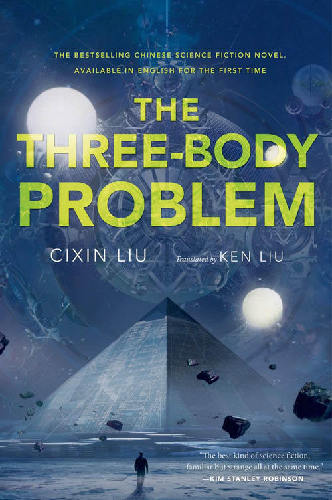The East Wind of Chinese Science Fiction Stirs the World
By staff reporter ZHOU LIN

The Three-Body Problem
Author: Liu Cixin
Price: US $25.99
Hardcover, 400 pages
Published by Tor Books
THE Three-Body Problem, the first of a science fiction trilogy titled Remembrance of Earth’s Past, is by Chinese bestselling author Liu Cixin, described as “one of China’s most celebrated sci-fi writers.” The novel was recently nominated for the 2014 Nebula Award for Best Novel. Established by the Association of Science Fiction and Fantasy Writers of America (SFWA), sci-fi professionals vote for Nebula Award nominees. This is why it is, along with the Hugo Award, regarded as a sci-fi Oscar.
Published in 2006, the book soon became one of China’s most popular sci-fi novels, with accumulative sales of 500,000 copies. Since November 2014, when The Three-Body Problem made its debut in the U.S., the overseas sales volume has exceeded 22,000. The second and the third volumes of the trilogy are reportedly to be published in succession.
The book’s global success was regarded as a huge event. The first Chinese sci-fi novel published abroad in English by Tor Books, well-known for its science fiction and fantasy titles, it was listed as No. 1 in the Asian First Day Bestsellers on Amazon.com. Moreover, less than one month after its publication, the book was nominated for the 2014 Top 100 Bestsellers released by National Public Radio.
Set under the backdrop of China’s “cultural revolution” last century, the plot revolves around a secret military project that sends signals into space to establish contact with other planets. Meanwhile, woman scientist Ye Wenjie has no idea that in the instant she sends signals to outer space she has drastically changed human destiny. The signal flits from the Earth at the speed of light directly towards the deepest heart of the universe. Four light years away, an alien civilization – the Three-Body Civilization – on the brink of destruction intercepts the signal and plans to invade Earth. Humankind’s Doomsday is then announced.
The book includes much scientific and technical terminology. However, rather than rendering the book hard to understand, Liu explains that “everything is written to serve the plot.” Scientific knowledge thus provides an authentic backdrop for the story’s logical and sophisticated plot.
The concerted warm response to this book is no accident. It is clear that the writer decanted every detail of the plot by looking back on the entire 20th century, during which the “big bang” theory appeared, two world wars ravaged the world, and great ideological changes occurred.
Shaken and disillusioned by these catastrophes and changes, people began to question their existing values and to lose their belief in science and respect for humanity. When aliens with advanced technology invade, however, the full absurdity of human infighting becomes clear. The book reveals the frustrated road of a developing civilization, and depicts the supreme human awe and veneration of technology.
Although the novel imbues profound criticism of human nature, the writer does not try to inspire blind worship of technological theory. According to Liu, humanistic concerns and technology are the book’s two main elements. The question of whether or not the development of technology could spell the doom of humanity or nurture a civilization Liu leaves open.
The Three-Body Problem has been critically acclaimed in the U.S. Reviews of it appear in essential media such as the New York Times, Washington Post, Chicago Tribune, and Publishers Weekly. The Wall Street Journal described it as: an imaginative novel so alluring that people may experience unimaginable discoveries.
Well known sci-fi novelist and scientist David Brin fully affirms the success of The Three-Body Problem in the U.S. It reflects various major issues of our times, and leaves no doubt that Liu stands at the forefront of world sci-fi writers.
The English translation by Ken Liu, an American Chinese sci-fi author in the U.S., adds to the book’s recommendability.
